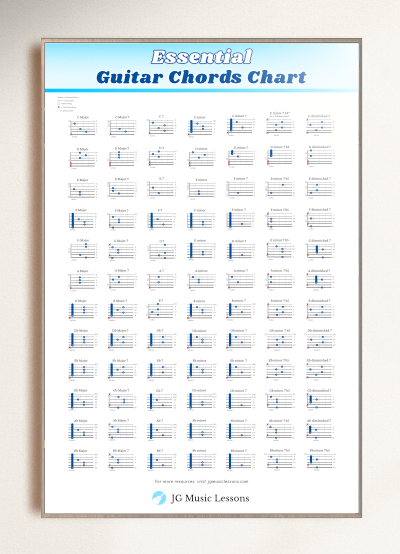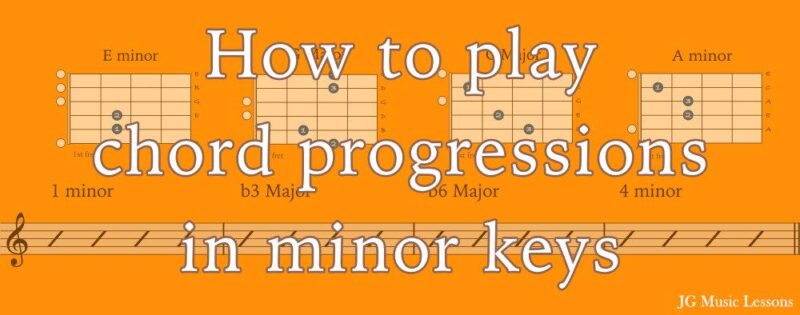Chord progressions are an important aspect of playing music because they make up the structure of a song to support the melody. A chord progression simply means a series of chords that are organized together to make up a section or whole part of a song.
In this lesson, we’ll specifically be looking at how to play chord progressions in minor keys to give you ideas for writing music or to use as a background for practicing scales and improvisation.
Let’s first go over some music theory to understand how related chords work in minor keys and then show you practical musical examples you can try out.
Related chords in minor keys
The way we can figure out which chords are related is by taking a minor scale and building triads or 7th chords starting on each scale degree. We would get different chord qualities starting on each degree of a minor scale.
For example, let’s find the related chords using the A minor scale which has the notes A, B, C, D, E, F, and G.
We get the following triad chords starting on each note:
- A, C, E = A minor (1 minor chord)
- B, D, F = B diminished (2 diminished chord)
- C, E, G = C Major (b3 Major chord)
- D, F, A = D minor (4 minor chord)
- E, G, B = E minor (5 minor chord)
- F, A, C = F Major (b6 Major chord)
- G, B, D = G Major (b7 Major chord)
All of these chords are related because they come from one scale. By the way, you might hear the music term “diatonic chords” to refer to related chords which come from one scale.
We can also build 4-note chords based on a minor scale to get 7th chord qualities. We’ll also use the A minor scale for this example.
- A, C, E, G = A minor 7 (1 minor 7 chord)
- B, D, F, A = B half diminished (2 half diminished)
- C, E, G, B = C Major (b3 Major 7)
- D, F, A, C = D minor 7 (4 minor 7)
- E, G, B, D = E minor 7 (5 minor 7)
- F, A, C, E = F Major 7 (b6 Major 7)
- G, B, D, F = G 7 (b7 Dominant 7)
If needed, check out this lesson to learn the essential 7th chords on guitar or half diminished (aka minor 7 b5 chords) on guitar.
Once you know what chord qualities belong to each scale degree, you can then apply this concept to any minor key.
Chords in minor keys
Here is a chart of related chords in all minor keys below.
| Minor key | 1 minor chord | 2 diminished chord | b3 Major chord | 4 minor chord | 5 minor chord | b6 Major chord | b7 Major chord |
|---|---|---|---|---|---|---|---|
| C | C minor | D diminished | Eb Major | F minor | G minor | Ab Major | Bb Major |
| D | D minor | E diminished | F Major | G minor | A minor | Bb Major | C Major |
| E | E minor | F# diminished | G Major | A minor | B minor | C Major | D Major |
| F | F minor | G diminished | Ab Major | Bb minor | C minor | Db Major | Eb Major |
| G | G minor | A diminished | Bb Major | C minor | D minor | Eb Major | F Major |
| A | A minor | B diminished | C Major | D minor | E minor | F Major | G Major |
| B | B minor | C# diminished | D Major | E minor | F# minor | G Major | A Major |
| Db | Db minor | Eb diminished | E Major | Gb minor | Ab minor | A Major | B Major |
| Eb | Eb minor | F diminished | Gb Major | Ab minor | Bb minor | B Major | Db Major |
| Gb | Gb minor | Ab diminished | A Major | B minor | Db minor | D Major | E Major |
| Ab | Ab minor | Bb diminished | B Major | Db minor | Eb minor | E Major | Gb Major |
| Bb | Bb minor | C diminished | Db Major | Eb minor | F minor | Gb Major | Ab Major |
Chord progressions in minor keys
In this section, we’ll look at some common minor chord progressions in different keys.
Guitar charts are included above the staff for the following examples but these progressions are also applicable to different instruments. You can also use the links in chords to learn multiple ways of playing them on guitar.
E minor chord progression
We’ll start with an easy minor chord progression using some basic chords you might already know. This first progression is 1 minor, b3 Major, b6, and 4 minor. In the key of E minor, the chords are E minor, G Major, C Major, and A minor.

D minor chord progression
This next progression has the chords 1 minor, 4 minor, 5 minor, and 1 minor. In the key of D minor, they are D minor, G minor, A minor, and D minor.

If needed, check out this lesson on how to play barre chords and 5 tips to get better at playing them.
C minor chord progression
This chord progression has the chords 1 minor, b7 Major, b6 Major, and 5 minor. In the key of C minor, they are C minor, Bb Major, Ab Major, and G minor.


G minor chord progression
This minor progression has the chords 1 minor, b7 Major, 4 minor, and 1 minor. In the key of G minor, they are G minor, F Major, C minor, and G minor.

F minor chord progression
This next chord progression is 1 minor, b3 Major, 4 minor, and 5 minor. In the key of F minor, the chords are F minor, Ab Major, Bb minor, and C minor.

B minor chord progression
For this minor chord progression, we introduce some diatonic 7th chords. The chords here are 1 minor, b3 Major 7, b6 Major 7, and 4 minor 7. In the key of B minor, they are B minor 7, D Major 7, G Major 7, and E minor 7.

A minor chord progression
This last progression also uses related 7th chords. The chords are b6 Major 7, 5 minor 7, 4 minor 7, and 1 minor 7. In the key of A minor, they are F Major 7, E minor 7, D minor 7, and A minor 7.

Wrapping up
If we take one minor scale and build triads or 7th chords on each scale degree, we can figure out the related chords that start on each note. Once you understand the music theory behind related chords, it will be much easier to create chord progressions in minor keys.
We covered all the related chords in minor keys as well as practical musical examples that you can apply to your instrument. Use these examples as a guide but also experiment with creating minor progressions that sound interesting to you.
Use your ear first to dictate your musical decisions and also use the theory to understand what you are creating. I hope this gives you some clarity to start coming up with your own ideas.
📘 Get the free guitar practice guide here!
Best,
JG Music Lessons
Start Playing Better, Faster
with Pro Membership! ✨
Get the guidance, tools, and support that keep your progress on track:
🏁 Always know what to practice next. Access the full Guitar Learning Roadmap with lessons in sequence.
🎼 Play songs with confidence. Step-by-step lessons of popular, classical pieces and other styles.
📙 Save time and frustration. Clear PDFs and ebooks that save time so you can focus on playing.
🎟️ Get rewarded for consistency. 2 free downloads every month (a $240+ yearly value).
🎁 Keep costs low while you grow. 50% off all charts, tracks, and posters — up to 75% off bundles.
🚫 Stay focused. Ad-free environment keeps you in the zone.
💬 Get help when you need it. Direct member support to keep you on track.

